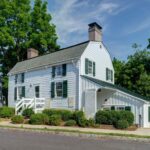Fleming House Museum and Gardens
 Samuel Fleming was born in Ireland on April 2, 1707. Around 1740, he moved to the area of Amwell, New Jersey, with his wife Esther and two small girls.
Samuel Fleming was born in Ireland on April 2, 1707. Around 1740, he moved to the area of Amwell, New Jersey, with his wife Esther and two small girls.
In 1741, Samuel obtained a tavern license. In 1744, he received a 210-acre property gift from Thomas Penn, son of William Penn. Samuel’s family had grown to ten children by 1756, with five girls and five boys. He built a three-story frame house for his family in was know as the meadow lot. Fleming modified the German bank-barn style, which was popular at the period, by adding a gambrel roof to give greater living space on the top floor of the house. He also constructed the structure on a knoll. He was able to create a floor that was partially below ground level by excavating through the rise. These innovations enabled him to construct the biggest house in Fleming’s Settlement at the time, a three-story structure. Samuel lost his home in 1766 owing to financial difficulties.
It is unknown where Samuel Fleming’s tavern was located. It was rumored to be on the King’s Highway, now Main Street, near the current post office location. During the Colonial period, a tavern was an important part of community life. Taverns served local customers in addition to travelers and offered a hot meal and libations. Villagers came here to socialize, hear the latest gossip, read a newspaper, do business, receive mail, or play a game of chance. Taverns were also used as courtrooms, boardrooms, and political gathering places.
